It took me 47 years of being in Australia to finally visit the little island state to the south -
Tasmania. AND It felt like being back in the north island of NZ, very similar landforms - lakes, mountains, gorges; same vegetation - cabbage trees, tree ferns, sedge, blackberries, gorse … and very similar weather. The main difference between NZ and Tassie, I think is the history - that of the penal colonies which existed in Tasmania and not in NZ.
Anyhow it's a lovely piece of country, very picturesque and quaint in many ways.
We flew into Hobart and rented a 4 berth motorhome. It served our needs accommodation-wise, as being there for a month we could use a lot of the free camp sites. However the front wheel drive of the vehicle was a real problem on wet bituminised roads and various other places. Dave reckoned it was an accident-in-waiting! It was still really convenient having a toilet and shower on board.
 |
| One of the free camps at Fingal |
Whilst in Hobart, some dear friends, Bob generously chauffeured us around to the sights and they both did an excellent job of entertaining us. It was great to have local knowledge to get us on our way. They were fabulous company as were Monty, Portia and Grizzle (the pet members of the family). Many thanks folks.
 |
| Bob and Di |
We visited Salamanca Markets which is apparently a 'must see' - certainly a huge array of locally made products - stylish clothing jewellery, organic produce, artworks etc.. Mother Nature spoiled it somewhat with RAIN but it was dry in the pub.
MONA - Museum of Old and New Art was on our list whilst in Hobart. It was one of my favourite places of visit so I have included quite a few photos and believe you me I have oodles more.
There was a fast ferry from central wharf along the River Derwent to Berridale Peninsula. It's probably a less travelled part of the Derwent so it was a good opportunity on the ferry to see it.
 |
| Jean viewing the sights along the Derwent |
The single storey MONA building appears at street level but is actually built into the side of the cliff. The interior has a spiral staircase that leads down to three larger levels of labyrinthine display spaces. There are no windows and on entering the museum, visitors descend a "seemingly endless flight of stairs". To see the art, the visitor must work back upwards towards the surface.
 |
| MONA from the water |
It is a bit of an eerie experience in a sense, with the subtlety of the light, the space and the way in which the installations have been skilfully choreographed. The architecture plays an enormous part in showcasing the exhibits, not to mention the beautiful raw sandstone walls.
Anyway it's a place that one could wander for hours and still be intrigued each time round. My favourite piece was "smashing wine glasses into a brick fireplace". Obviously I don't have photos of that. Another fav was the bit.coin exhibit - a waterfall of words. I should have videoed it to get the real effect.
.
 |
| Bit.coin
How do artists think to make something like this …. very effective though.
|
 |
| Wall of vaginas |
 |
| Ropes galore |
 |
| Theres a gold fish swimming around in there, he was shy for the camera |
 |
| Sidney Nolan's "Snake" mural displayed for the first time in public |
Cloaca, a machine which replicates the human digestive system and turns food into faeces, excreting it daily. It's fed at 11am and 2pm and poos at 4pm
 |
| Shit machine |
Next place we visited after leaving Hobart was the historic town of Richmond.
It is a delightful Georgian village, holding many historic landmarks built in the early part of the 1800's.
We visited the markets and at the entrance was this harpist. Apparently the harp was made of Huon Pine so it would be quite valuable. However the music was just magnificent, Jean the 'ever romantic' was enchanted with the playing of "La vie en rose".
The Richmond bridge is the main attraction in the town but a really old gaol and Catholic Church are as well. The Main Street has been beautifully preserved with the Georgian architecture.
 |
| Jean in front of the oldest bridge in Australia |
Heading South towards the Tasman Peninsula we made our way to the Port Arthur Historic Site. I was surprised to learn that it was more than a prison. Back in it's day it was a complete community - home to military personnel and free settlers. The convicts worked at farming and industries producing a large range of resources and materials.
The Port Arthur Historic Site contains more than 30 historic buildings, extensive ruins and beautiful grounds and gardens. It really has been carefully preserved.
 |
| The settlement from the water - large building in front is the penitentiary where most of the convicts were 'housed' |
 |
| Dave 'guarding' the Guard House |
 |
| As you can see, ruins is what mostly remains |
 |
| The grounds are impeccably kept and gardens are just gorgeous - the actual point of the photo was to show that Tasmania does have glorious days at times! |
Within the complex was "The Separate Prison". This place was designed to deliver a new method of punishment, of reforming the convicts through isolation and contemplation. Convicts were locked for 23 hours each day in single cells. Here, they ate, slept and worked with just one hour a day allowed for exercise, alone, in a high-walled yard.
IT WAS A VERY SOBERING EXPERIENCE to walk through this place and imagine life as non communication or contact for their prison sentence.
As part of the convict trail we also visited the Coal Mines Historic Site. Here they attempted to combine convict discipline with industrial productivity, but the experiment was short-lived due to lack of skilled miners and a low quality coal.
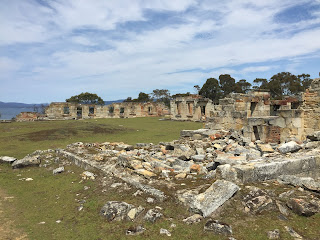 |
| Part of the ruins of the Coal Mines |
An abundance of natural beauty - some really rugged which I can imagine it could be quite harsh and cruel in the winter.
From the South East we ventured a little North of Hobart and out towards the West into the Lakes District, especially to a place called Strathgordon. In the early 1970's David visited with a local fellow and he simply wanted to re-visit to see what, if anything had changed.
 |
| Dave descending the stairs to the dam wall at Strathgordon |
 |
| Lake Pedder |
 |
| Tarraleah hydro pipes - quite spectacular on the landscape |
He wasn't disappointed, the places had 'grown' or remained pristine. We tried on many occasions to contact an 'old friends brother' at Lake Brady but couldn't quite co-ordinate meetings. He was away crayfishing as the season had just opened. Pity Peter!
Our next port of call was Strahan over on the west coast. We had to pass through a place called Queenstown. This place is renowned for it's mining heritage. The discovery of gold and copper deposits in the 1880's led to the opening of the vast operations of the MT Lyell Mining and Railway Co. The forests that once grew were felled to stoke the furnaces of the many mining companies in the early days and also the smelting process produced sulphur fumes which destroyed the remaining vegetation. When the smelting was discontinued in 1969 fresh growth has since begun to appear.
 |
| Queenstown is nestled in the valley |
The Queen river in Queenstown still runs yellow (from the sulphur) to this day but I think it's only stained the rocks and stones. (it's not a good look for a river).
 |
| Empire Hotel |
One of the miners pubs in Queenstown. The centrepiece of the pub is the magnificent Blackwood staircase. The Blackwood timber was cut on the West Coast then taken to England, fashioned there and bought back to be installed in the hotel.
Over the range we continued on our travels to Strahan. We stayed there for 3 days as there was a lot to be seen in the area.
 |
| John and Merle |
West Coast Wilderness Railway
Dave has a fondness for steam 'things' and since there was an all day trip from Strahan to Queenstown return on a steam train we decided to indulge ourselves. In heritage carriages pulled by a steam engine we set out from Regatta Point Station; the journey took us deep into the cool temperate rainforest, we crossed historic bridges, travelled alongside the King River viewing some unbelievable gorges, we stopped at historic stations along the line and were able to walk in the rainforest on toilet stops. The pinnacle of the trip (for most men who understand and are interested) is in the operation of the Abt rack and pinion section of the line.
 |
| hmmmm, amazing ….. |

Mr and Mrs Peters on board!
There was a great on board commentary which all added to making a great trip.
The following day, unfortunately the weather turned crook on us, rain, wind, the lot, all day….
However we had a cruise on the Macquarie Harbour and Gordon River booked and because the vessel was purpose built for 'shitty' weather - safe, comfortable and all-round views we carried on like nothing was amiss.
This particular trip was my suggestion as I had read and loved the book "For the term of his natural Live" and a lot of the story happened in this part of the country. So off we went in shocking weather …. Photos were difficult to take through rain spotted windows.
 |
| heading out to Hells Gates |
the fish farms - all the aquaculture pens stocked with thousands of Atlantic Salmon and Ocean Trout;
exploring Sarah Island which was one of the harshest convict settlements in Australia;
slowly cruising down the Gordon River which is a world heritage listed site. We disembarked at Heritage landing to stroll through the ancient forests of Huon Pine, leatherwood, Blackwood etc.
 |
| A break in the rain, only the wind to contend with! |
Despite the inhospitable weather, it was a great day, the buffet lunch was superb and the wine particularly good!
That same evening we went to a live performance of a play "The Ship That Never Was". It was a dramatic re-telling of the great escape from Sarah Island. It was an audience participation play which we were aware of but sitting in the back row didn't help us. In amongst others I was picked as the ship's parrot. Initially it didn't seem so bad as I just had to hold a finger puppet of a parrot and on cue had to "squawk and screech" like a parrot. Dave took some video of the performance but alas it doesn't seem to want to work!
Further on in the story, the rules changed and I had to go on stage, complete in a parrot cape and say the same silly lines but in front of the audience! It was quite good simple fun but would have been easier if I'd had a few drinks beforehand.
However that was the end of our West Coast trip. We travelled in the rain North to around places like Derwent Bridge, and North West to Arthur River. Arthur River, wild and windy, is coined as "the edge of the world" with pristine coastline and 'refreshing' winds from the Roaring Forties.
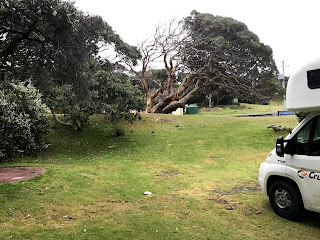 |
| A great free camp at Arthur River |
 |
| Wild waters at the entrance to Arthur River |
In amongst intermittent rain, we travelled to Stanley which was a charming little town on the very North West of Tassie.
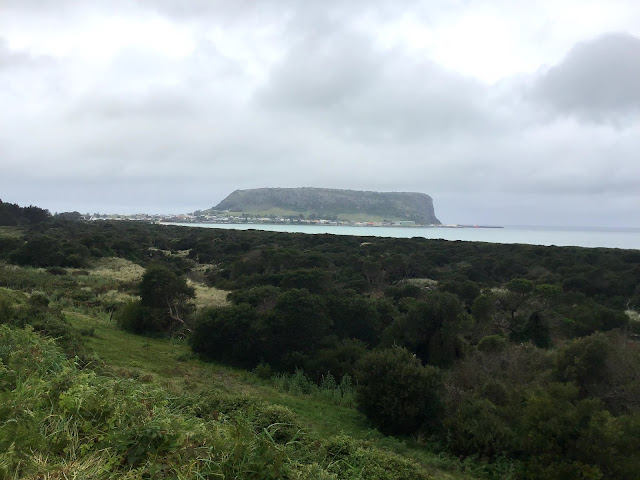 |
| The unusual landform is referred to as The Nut |
A book that our BookClub read was "The light between oceans" and I didn't realise til we got to Stanley that the film was staged here in town. As a consequence a lot of the buildings had been spruced up for the film which was set in the early 1900's.
While at Derwent Bridge we did stop at the "Wall in the Wilderness". It is an artists unique interpretation of Tasmania's past with Huon Pine artworks. It consists of 100 hand-sculpted timber panels, each one metre wide and three metres high. For the contemporary art lover this is a magnificent representation of history chiselled by hand in pine. The detail in the pictures is simply amazing, it was well worth the visit. No photos are available as the artist (possibly a grumpy old man) prohibited any form of cameras in the shed, as he did with behaviour of unruly children and the piano was not to be played either! However, a beautiful work of art, in my opinion.
 |
| Part of the Cradle Mt National Park |
I had a blast of a time in Burnie, I discovered a Rhododendron Garden (over 11 acres). As you may know when they are in flower it usually covers the entire tree, truly beautiful to the eye. WOW!
 |
| Magnificent specimens of Rhodendron |
Having travelled along the Northern coastline, we changed directions and headed inland to a couple of inland towns - Railton, Sheffield, Deloraine, Rosedale and several little townships. All the blossoms, different crops, rolling green farmland, it was very scenic at times. Something that seemed to be in common all along these roads were the abundance of firewood - every dwelling had piles and fence lines lined with firewood - obviously cold at times!
Most of the little towns had their share of historic buildings and shop fronts retain their original facades, some were going to the trouble of re-inventing themselves such as Railton is now known as the town of topiary. A garden artist has tended trees down the Main Street and a sizeable section in one of the side streets - depicting local fauna and historical events of the area. Also the town of Sheffield is known as The town of Murals, an artist has painted shop walls with pictures of agricultural or historical events. Apart from being very colourful, it adds another dimension to the local economy bringing in the tourist dollar. All the little towns, without exception, we found to be very friendly and inviting. Another common factor were the picturesque cottage gardens in most yards. Even alongside the road there were kilometres of native shrubs in flower, very colourful and interesting to see the different plants in flower. I'm glad I wasn't driving or I'd missed a lot of the beauty.
 |
| Railton |
 |
| Low Head |
Another little town, Low Head, had carved wooden figures depicting historical characters. A talented carver for sure.
Ledgerwood, a township in the middle of nowhere had an avenue of 12 trees - they were devoted to servicemen from the area who were killed in service overseas, a wonderful tribute for the families.
 |
Ledgerwood
A great specimen in the Evercreech Reserve
|
 |
| Giant Eucalyptus |
 |
| Lilydale |
Anyway we had fun hacking our way around 9 holes. It wasn't that difficult unless you were silly enough to get into one of the treacherous bunkers - I did once and decided it was far more sensible going out backwards.
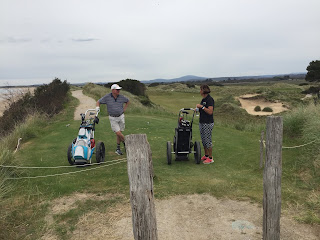 |
| TC and me |
I parred one hole and lost one ball only, which is all you need to know. Too expensive for hackers though. It was probably 'a game in a lifetime' and I'm lucky to have had the opportunity.
We went through Launceston a few times but didn't spend much time looking around. I reckon the state of the Tamar River was enough to put anyone off!
Along the Tamar Valley we came to the town of Beaconsfield, known for the Mine and Heritage Centre. David nosed around in here while I spent a delightful 1/2 day at Beauty Point admiring the Seahorses and seeing the Platypi and Echidnas. Aaaaaaaaah, the sea horses are delightful little creatures, very colourful and unique in a couple of ways.
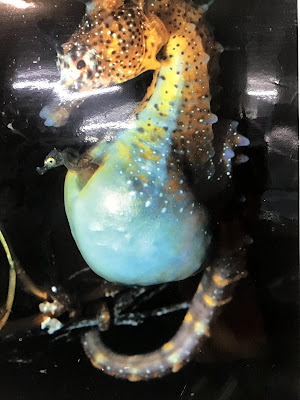 |
| Male is giving birth! |
I didn't realise they (platypus) grew so large and George is very territorial and aggressive. They (the male) have a habit of killing the female if they dislike them. In the tanks, he had a tunnel only to Dora who he got on with. Poor Dora!
Oatlands is along the Heritage Highway which follows much of the original route between Launceston and Hobart, built by convict road gangs in the early 1800's. Most of the buildings are of sandstone in the Main Street. Even the new police station is in sandstone.

Also in town is a restored Georgian windmill, the Callington Mill
 |
| Beautiful cottage garden with the windmill in the background. |
Having pottered around the North and interior of the island we headed to the East Coast where we expected to see some lovely white beaches and we did, also the weather changed for the better as well.
 |
| A beautiful day at Kettering Beach |
At Freycinet National Park, on a coastal walk with TC and Katrina. Fortunately the rain had halted so walking weather was good as was the company.
 |
| I thought the cloudy sky would add some character to the scene … |
 |
| Jean with the iconic Wine Glass Bay in the background |
One of the few wineries, we visited and tasted vino …. simply divine flavours and the view absolutely spectacular. I can recommend any drop of the different Devils Corner wines, much cheaper than any bottle shop as well! We had a very relaxing and entertaining arvo here, sampling and playing Finstra. It was great fun.
 |
| The Devils Corner Cellar Door overlooking Oyster Bay |
After the East Coast - Bay of Fires, St Helen's Triabuna, Orford, Bicheno, Swansea et al, we headed south of Hobart to Huonsville, Snug, Franklin, Geeveston and far south as Southport. Weather was 'pretty crappy' so it was more driving than walking.
On the third last night we encountered a house battery problem with the motorhome. The very inconvenient incident required us to break our trip and visit an auto-electrician.
 |
| Jean and Di |
On the last two days of our stay in Hobart we were at the Warne's household again. On this occasion we cleaned up the motorhome before returning it to the depot. Once again, The Warne accommodation was so generous, thanks folks.
All in all, the holiday and the trip was a lovely, leisurely time seeing some awesome sights, scenery and beautiful countryside. Friends involved made it extra special but it was a positive experience and will have a special place in our memories.
TERRIFIC TASSIE!




















No comments:
Post a Comment